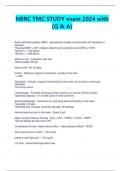NBRC TMC STUDY exam 2024 with
(Q & A)
Brain natriuretic peptide (BNP) - Secreted by cardiac muscles when HF develops or
worsens
*Elevated BNP = CHF (helps to determine if symptoms are COPD or CHF)
*Normal = < 100 pg/mL
*Severe = > 900 pg/mL
Mantoux test - Tuberculin skin test
*Most reliable TB test
Normal HR - 60-100 bpm
Flutter - Rapid but regular contractions, usually of the atria
* > 200
Fibrillation - Chaotic, irregular contractions of the heart, as in atrial or ventricular
fibrillation
*too fast to count
Oscilloscope - Provides continuous heart activity on a monitor (ECG monitor)
*generally displays 1 or 2 leads (Lead II most common)
Electrocardiograph - Instrument for recording electrical activity of the heart
*generally 12 leads
*identifies axis changes, ischemic damage, MI damage
Normal electrical axis in the heart - Down & left
Mean Airway Pressure formula - Paw = (PIP - PEEP) x Ti/Ttot + PEEP
*Should always be less than CVP
Compliance formula - delta volume (Vte) ÷ delta pressure (Pplat - PEEP)
Norm glucose term infant - > 30 mg/dL
preterm infant glucose - > 20 mg/dL
L/S ratio - lecithin/sphingomyelin ratio
,*2:1 = good
*< 2:1 = high risk of HMD/IRDS (lower ratio = higher risk)
ETCO2 norm - 3 - 5%
Leads vs Electrodes - *Electrode = conductive pad attached to the skin
*Lead = graphical analysis of heart activity
What lead is examined when 12 are given - Lead II
Age of "term" infant - 38 - 42 weeks
LGA - Large for gestational age
SGA - Small for gestational age
TPAL - Term, Preterm, Abortion (spontaneous or elective), Living
APGAR - Appearance, Pulse, Grimice, Activity, Respirations
*0 = Real bad
*1 = Bad
*2 = Good
APGAR score & actions - Appearance, Pulse, Grimice, Activity, Respiratory effort
*0 - 3 = resuscitation
*4 - 6 = support, stimulate, warm, O2
*7 -10 = monitor, routine care
Normal infant temp - 36.5 C
Normal infant HR - 110 - 160
* > 170 = Tachy
* < 100 = Brady
*Can only increase CO by increasing HR
Norm infant RR - 30 - 60
*Resp pause: apnea = 5 - 10 sec --> normal
*Short apnea = 10 - 20 sec --> May be normal
*Long apnea = > 20 sec --> always abnormal
Norm infant BP - 60/40
Preterm = 50/30
Norm infant weight - > 3000g (3kg)
*28 wk GA = 1000g
, Acrocyanosis - Bluish extremities
*Not true cyanosis
Signs of infant resp distress - Grunting, retractions, nasal flaring
Silverman score - 0-10, assessment of resp distress
*The higher the score, the greater the distress
4 life functions (in order) & assessment for them - Ventilation - RR, VT, BS, chest.
movement, PaCO2, EtCO2
Oxygenation - HR, Skin Color, Sensorium, PaO2, SpO2
Circulation - HR & strength, CO
Perfusion - BP, sensorium, temp, urine output, hemodynamics
Tobacco use, smoking status - # packs per day X # of years smoked = pack years
Pysical inspection (IPPA) - Inspection
Palpation
Percussion
Auscaltation
Normal urine output - 40mL/hr = 1L/day
Sensible water loss reasons - urine, vomiting
Insensible water loss - Lungs, skin
Affects of intake exceeding output - Weight gain, electrolyte imbalance, increased
hemodynamic pressures, decreased lung cst
Normal CVP (central venous pressure) - 2-6 mmHg
Decreased CVP & indications - < 2 mmHg = hypovolemia = fluid therapy
Increased CVP & indications - > 6 mmHg = diuretics (furosemide aka Lasix)
Orientation x3 - Time, Place, Person
Orthopnea is: - difficulty breathing while lying down (CHF)
Dyspnea grades - Grade I: unusual exertion
Grade II: up hills or stairs
Grade III: walking at normal speed
Grade IV: slowly, walking short distance




